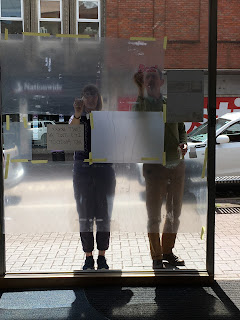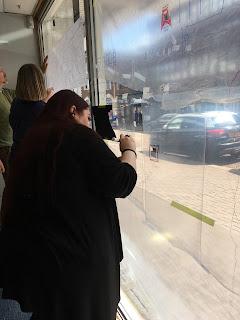Quote: Claire Colebrook, Death of the PostHuman: Essays on Extinction, Vol. 1
For some years, I have kept the image above on my Mac desktop. It reminds me of what inspires me to make art in the way I do and why I think making art like this matters. It is a photograph of the abrupt ending of a freshly lain path at the edge of a new housing development near my home. The imported sand and gravel burbles off at the end into a sea of clarty brown marl, giving lie to its obvious intention to join up with the older path looping round the spinny giving access to the Rec and its marshy boundary of the golf course. Instead, you must hop through a gap in the hedge, walk the verge by the road and then broach the spinny via another gap.
These days, the spinny resides in a different parish to the the new housing development which wouldn't have been built at all if a pre-2014 environmental report, stating that green space had already been reduced to pockets and there was no more room for houses, had been upheld. This one field this side of the railway was all that was left from the old farms. Instead, the parish boundaries were moved so that it became enclosed by the neighbouring parish belonging to a village more than a mile away, between which conveniently lay much green (yet unaccessible) space.
The houses were duly built and I spent 2017 and 2018 exploring, cataloguing, collecting, and making art, about the changing environment and affects of home building made on the ground. A great deal of material from the building site ended up causing pollution; foam, metal, plastic, blown and scattered around, but it was the path that provided a prime example of what Beatrice Cortez' paragraph, which hovers above it in my image, is set radically against:
If we consider, following Deleuze and Gattari, that every face and every object diagrams the space in front of them, due to the massive scale of hyperobjects, we imagine their diagraming of space in non-human ways, not as a landscape in front of us, not as an environment around us. This brings us to a question posed by Claire Colebrook: “[C]an we imagine a mode of reading the world, and its anthropogenic scars, that frees itself from folding the earth’s surface around human survival?” (Claire Colebrook)
There is a huge amount just in this one paragraph, and the point of my blog is not to explain it — the link to the essay is above — but to explain its significance to me.
What grabs me is the complexity in the to-and-fro-ness of the act of ' imagin(ing) a mode of reading the world ~ that frees itself from folding the earth’s surface around human survival', of trying to understand the world, with all our pasts and continuing processes happening, all the while being within it yourself, during which you try to convince yourself against lifetimes of conditioning, that yourself, and all others like you, are not the most important lives in it.
For once you get into that non-survival frame of mind that thinks of the human species not as a hierarchy but as one of many; as part of a flatter organisation of many, many beings — and things, because we are amalgamations of objects/things too as well as living things — merely walking minerals (3) — then you realise that the world, and all its pasts and processes, are also looking back at you and that the space you live in is shared on many levels; and most of them don't know you exist just as much as you don't know that they exist.
This mode of sharing space sent me on a trail of looking for where the other beings who look at us are, and how they exist in the spaces we tend to think of as ours.
This sent me to where moss and pigeons live. Perhaps this is predictable — to go to the macro places; the literal cracks that moss and lichens inhabit, the largest of the small and overlooked places visible to the naked eye, especially once those being gather together and cover a surface, and to the lowest of the old hierarchy — 'the rats of the sky' — but there's the clue: if you flatten your hierarchy, it's the ones at the bottom that are used to living there that may provide much needed clues on how to live.
Much is done in our cities to prevent other species clinging on; impenetrable self-cleaning glass office towers, the corralling of 'Nature' into other places, parks and peripheries, away from our machines, homes and working spaces; a belief that there can somehow be an allotted percentage acceptable per population figure. This is not a manifestation of enmeshment within a shared ecosystem.
1. Beatriz Cortez ‘The Face as a Hyperobject’ Chap 14 in Hyperobjects for Artists, A reader, edited by Timothy Morton and Laura Copelin with Peyton Gardner
2. Claire Colebrook, Death of the PostHuman: Essays on Extinction, Vol. 1, (Ann Arbor, MI: Open Hu- manities Press, 2014), 3.
3. Jane Bennet, Vital Materials




















































